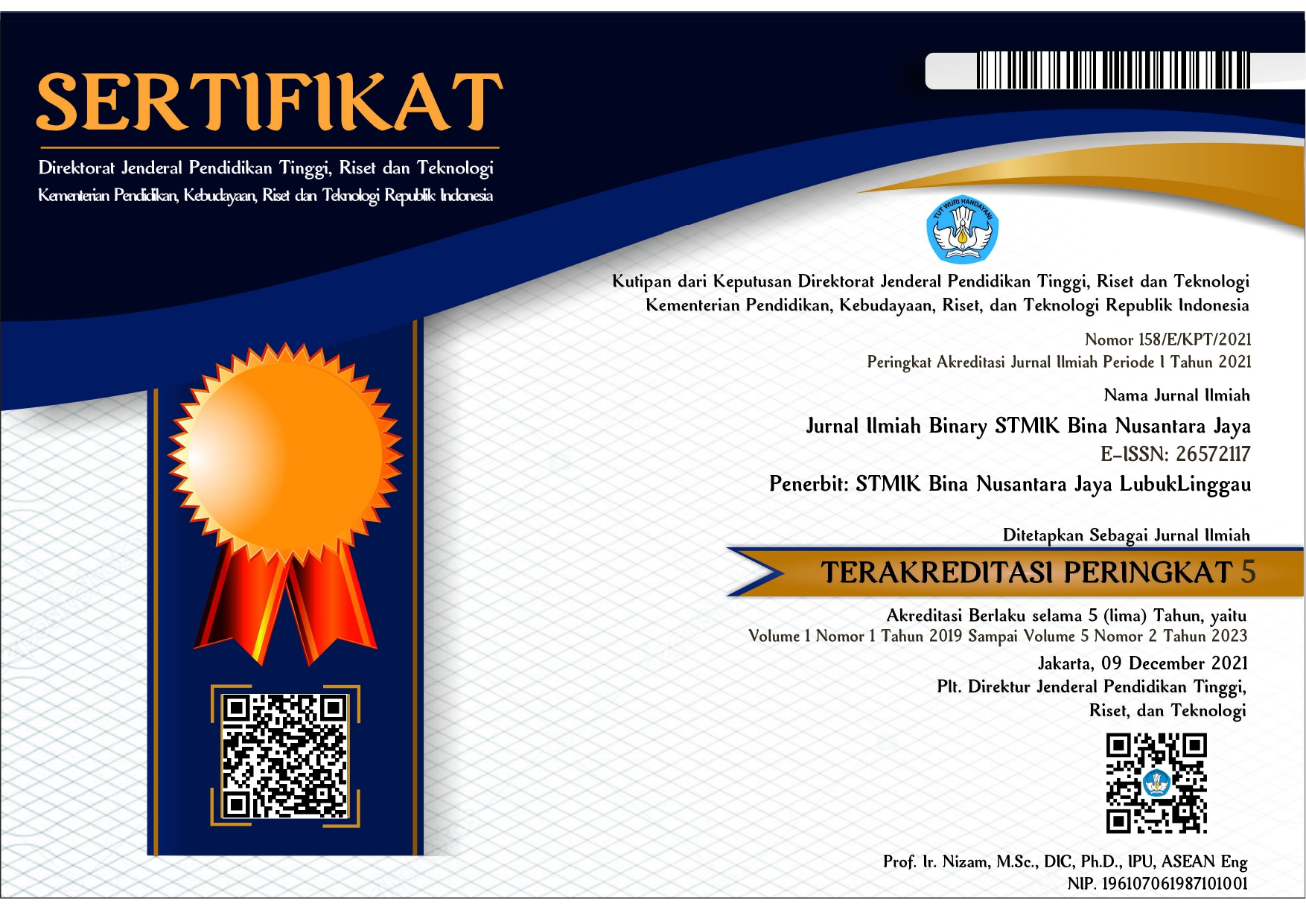Penerapan Hidden Markov Model untuk Prediksi Pergerakan Harga Bitcoin
Abstract
Pergerakan harga Bitcoin yang sangat fluktuatif dan volatil telah menjadi tantangan bagi para investor dan peneliti dalam melakukan prediksi harga secara akurat. Penelitian ini bertujuan untuk mengimplementasikan metode Hidden Markov Model (HMM) dalam menganalisis dan memprediksi pergerakan harga Bitcoin dengan pendekatan berbasis machine learning. Tujuan utama dari penelitian ini adalah untuk mengembangkan model prediksi yang mampu mengidentifikasi pola tersembunyi dalam data historis harga Bitcoin dan memberikan insight mengenai kondisi pasar, apakah sedang berada dalam tren naik (bullish), tren turun (bearish), atau stabil (sideways). Metode yang digunakan adalah unsupervised learning dengan pendekatan HMM berbasis Gaussian, menggunakan data harga penutupan (close), moving average (MA200), dan volume perdagangan Bitcoin dari tahun 2020 hingga 2025. Proses penelitian mencakup praproses data, ekstraksi fitur, pelatihan model HMM, dan visualisasi hasil berupa klasifikasi status pasar dan analisis transisi antar status. Hasil penelitian menunjukkan bahwa model HMM berhasil mengelompokkan data ke dalam tiga status tersembunyi dengan interpretasi tren yang konsisten terhadap kondisi pasar aktual. Status sideways mendominasi sepanjang periode, diikuti oleh status bearish dan bullish. Durasi rata-rata masing-masing status menunjukkan bahwa bearish berlangsung lebih lama dibanding bullish, yang hanya muncul secara singkat. Analisis transisi antar status memperkuat pemahaman terhadap pergerakan pasar kripto. Kesimpulannya, metode HMM terbukti efektif untuk mengidentifikasi pola pergerakan harga Bitcoin dan dapat dijadikan dasar dalam pengembangan sistem prediksi dan peringatan dini di pasar aset digital.
References
[2] Y. Zou and D. Herremans, “PreBit -- A multimodal model with Twitter FinBERT embeddings for extreme price movement prediction of Bitcoin,” Expert Syst Appl, May 2022, doi: 10.1016/j.eswa.2023.120838.
[3] R. Pandey, “Bitcoin Price Prediction Using Machine Learning Algorithms,” Government Polytechnic College Betul M.P. India, Jan. 2025, doi: 10.21203/rs.3.rs-5801301/v1.
[4] Z. Gao, Y. He, and E. E. Kuruoglu, “A Hybrid Model Integrating LSTM and Garch for Bitcoin Price Prediction,” in 2021 IEEE 31st International Workshop on Machine Learning for Signal Processing (MLSP), 2021, pp. 1–6. doi: 10.1109/MLSP52302.2021.9596429.
[5] R. Kaur et al., “Development of a cryptocurrency price prediction model: leveraging GRU and LSTM for Bitcoin, Litecoin and Ethereum,” PeerJ Comput Sci, vol. 11, 2025, doi: 10.7717/peerj-cs.2675.
[6] M. Li, “Prediction of Bitcoin Price Based on the Hidden Markov Model,” Advances in Economics, Business and Management Research, vol. 203, 2021, [Online]. Available: https://cn.investing.com
[7] C. Koki, S. Leonardos, and G. Piliouras, “Exploring the Predictability of Cryptocurrencies via Bayesian Hidden Markov Models,” Nov. 2020, [Online]. Available: http://arxiv.org/abs/2011.03741
[8] H. Joshi, “VWAP Forecasting for a Stock using Machine Learning,” International Journal of Engineering Research & Technology, vol. 10, no. 05, pp. 234–237, May 2021, [Online]. Available: www.ijert.org
[9] M. Yousaf, M. Tariq, A. Jabbar, and S. Jalil, “A Comprehensive Survey of Cryptocurrency Forecasting Methods, Trends, and Challenges,” Dec. 2024, doi: 10.20944/preprints202411.2330.v2.
[10] I. Palupi, B. A. Wahyudi, and A. P. Putra, “Implementation of Hidden Markov Model (HMM) to Predict Financial Market Regime,” 2021 9th International Conference on Information and Communication Technology (ICoICT), Sep. 2021, doi: 10.1109/ICoICT52021.2021.9527459.
[11] K. Dingle, P. Batlle, and H. Owhadi, “Multiclass classification utilising an estimated algorithmic probability prior,” Physica D, vol. 448, Dec. 2022, doi: 10.1016/j.physd.2023.133713.
[12] E. F. Montesuma, F. N. Mboula, and A. Souloumiac, “Recent Advances in Optimal Transport for Machine Learning,” IEEE Trans Pattern Anal Mach Intell, vol. 47, no. 2, pp. 1161–1180, Jun. 2023, [Online]. Available: http://arxiv.org/abs/2306.16156
[13] J. K. Grewal, M. Krzywinski, and N. Altman, “Markov models - Markov chains,” Nat Methods, vol. 16, no. 8, pp. 663–664, Aug. 2019, doi: 10.1038/s41592-019-0476-x.
[14] B. Mor, S. Garhwal, and A. Kumar, “A Systematic Review of Hidden Markov Models and Their Applications,” Archives of Computational Methods in Engineering, vol. 28, no. 3, pp. 1429–1448, 2021, doi: 10.1007/s11831-020-09422-4.
[15] C. Chatfield, The Analysis of Time Series: An Introduction, Sixth Edition. 2016. doi: 10.4324/9780203491683.
[16] A. Bouteska, M. Z. Abedin, P. Hajek, and K. Yuan, “Cryptocurrency price forecasting – A comparative analysis of ensemble learning and deep learning methods,” International Review of Financial Analysis, vol. 92, Mar. 2024, doi: 10.1016/j.irfa.2023.103055.
[17] Q. Zhao, “A Deep Learning Framework for Predicting Digital Asset Price Movement from Trade-by-trade Data,” Oct. 2020, [Online]. Available: http://arxiv.org/abs/2010.07404
[18] M. Glenski, T. Weninger, and S. Volkova, “Improved Forecasting of Cryptocurrency Price using Social Signals,” Jul. 2019, [Online]. Available: http://arxiv.org/abs/1907.00558
[19] S. Biswas, M. Pawar, S. Badole, N. Galande, and S. Rathod, “Cryptocurrency Price Prediction Using Neural Networks and Deep Learning,” in 2021 7th International Conference on Advanced Computing and Communication Systems (ICACCS), 2021, pp. 408–413. doi: 10.1109/ICACCS51430.2021.9441872.
[20] M. B. Bosire and S. C. Maina, “Modelling Stochastic Volatility in the Kenyan Securities Market Using Hidden Markov Models,” Journal of Financial Risk Management, vol. 10, no. 03, pp. 367–395, 2021, doi: 10.4236/jfrm.2021.103021.
[21] L. Oelschläger and T. Adam, “Detecting bearish and bullish markets in financial time series using hierarchical hidden Markov models,” Stat Modelling, vol. 23, p. 1471082X2110340, May 2021, doi: 10.1177/1471082X211034048.











